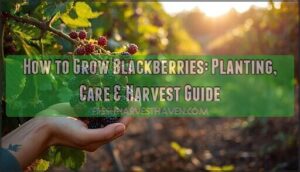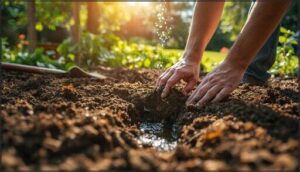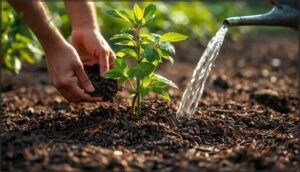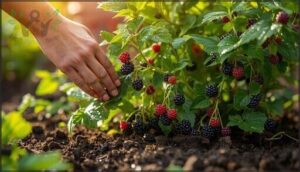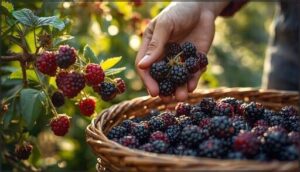This site is supported by our readers. We may earn a commission, at no cost to you, if you purchase through links.
Blackberries are deceptively simple to grow, but most home gardeners stop harvesting after the first season because they didn’t plan ahead. The difference between a tangled mess that produces a handful of berries and a productive patch that yields pounds of fruit comes down to a few critical decisions made before you ever plant a single cane.
Choosing the right variety for your space, preparing your soil properly, and understanding how to prune for maximum yield transforms growing blackberries from a guessing game into a reliable process.
Whether you want just enough for fresh eating or enough to preserve for winter, the path forward is the same—start with the fundamentals, stay consistent, and you’ll have blackberries flourishing for years.
Table Of Contents
- Key Takeaways
- Choosing The Best Blackberry Varieties
- Preparing The Ideal Planting Site
- How to Plant Blackberries
- Caring for Blackberry Plants
- Harvesting and Storing Blackberries
- Frequently Asked Questions (FAQs)
- How long until blackberries produce fruit after planting?
- Can blackberries grow well in containers or pots?
- What causes blackberries to taste sour or bland?
- Do blackberry plants spread aggressively through runners?
- How do you overwinter blackberry plants successfully?
- How often should I harvest blackberries during peak season?
- Can I grow blackberries in containers or pots?
- What is the yield timeline for mature blackberry plants?
- How do I propagate blackberries from existing canes?
- What common pests and diseases affect blackberry crops?
- Conclusion
Key Takeaways
- Choose between erect blackberries (3-6 pounds per plant, less space) and trailing varieties (up to 20 pounds per plant, require strong trellising) based on your space and yield goals.
- Prepare your soil to a pH of 5.5-6.5 with proper drainage, organic matter, and full sun (at least 8 hours daily) before planting to avoid the 50% yield loss that comes from inadequate conditions.
- Prune to maintain 4-6 healthy canes per plant in late winter, tip primocanes at 3-4 feet during summer, and use a T-trellis system to boost lateral branching and reduce disease pressure.
- Expect your first small crop 12-18 months after planting, with substantial harvests by year two and full commercial yields by year three when plants consistently produce 5-10 pounds annually.
Choosing The Best Blackberry Varieties
Before you plant a single cane, you’ll want to understand the different types of blackberries and what they need to thrive. Your choice affects everything from how much space you’ll need to how you’ll manage the plants through the seasons.
Let’s break down the main varieties so you can pick the best fit for your garden.
Erect Vs. Trailing Blackberries
When choosing between erect and trailing blackberries, you’ll notice big differences in yield, structure, and care. Erect blackberries produce 3 to 6 pounds per plant with sturdy, upright canes needing minimal support. Trailing varieties yield up to 20 pounds per plant but require strong trellising for their 15- to 20-foot canes.
Erect types offer better cold hardiness and firmer fruit for fresh markets, while trailing blackberries deliver sweeter, juicier berries mainly used for processing.
To help guarantee best growth, consider annual spring fertilization.
Thornless and Thorny Varieties
Beyond structure, thorny versus thornless blackberry varieties differ greatly in yield, quality, and care. Thorned plants can produce up to 4 quarts per plant—nearly double some thornless types—though modern cultivars like ‘Ouachita’ challenge this gap. Blackberries also need to be planted where they receive full sun for best growth.
Consider these key differences:
- Thorny varieties often show stronger disease resistance
- Thornless types offer safer, easier harvesting
- Fruit quality varies by specific cultivar, not just thorns
- Market trends favor thornless for commercial and home gardens
Selecting Cultivars for Your Climate
Your climate shapes which blackberry varieties will thrive. Cold hardiness matters—’Illini Hardy’ tolerates Zone 4 winters below -20°F, while thornless cultivars suit Zones 6-8.
Heat tolerance varies too: ‘Navaho’ excels in southern heat, needing fewer chill hours than northern types.
Disease resistance and yield variation differ widely across regional trials. Check your hardiness zone and consult local extension data before selecting cultivars suited to your specific conditions.
Preparing The Ideal Planting Site
Getting your planting site ready is like setting the foundation for a house—you want everything solid from the start. Blackberries aren’t too picky, but they do have a few non-negotiables regarding soil, sun, and drainage.
Preparing your blackberry planting site is like building a house foundation—you want everything solid from the start
Let’s walk through what you need to check before those canes go in the ground.
Soil PH and Nutrient Requirements
Your blackberries won’t thrive if the soil isn’t ready. Ideal pH between 5.5 and 6.5 ensures strong roots and nutrient uptake. Soil testing reveals what you’re working with, so test four to six months before planting.
Macronutrient balance—nitrogen, phosphorus, and potassium—fuels cane growth and fruiting. Don’t forget micronutrients like iron and magnesium.
Add organic matter to improve soil drainage and boost organic content for healthier plants.
Sunlight and Spacing Needs
Without adequate sunlight, your blackberries won’t reach their potential. Full sun—at least eight hours daily—is essential for strong yields and disease prevention. Light intensity directly influences fruit production, while proper row orientation and plant density improve air circulation and reduce fungal issues.
Soil drainage matters too, but proper spacing ensures sunlight reaches every cane.
Key spacing guidelines for your planting site:
- Erect varieties: Space plants 3-4 feet apart within rows
- Trailing types: Allow 6-10 feet between plants
- Row spacing: Maintain 10-12 feet between rows for equipment access
- Sunlight exposure: Sites with under six hours lose over 50% yield potential
- Air circulation: Wider spacing prevents anthracnose and foliage diseases
Improving Drainage and Adding Organic Matter
Since poorly drained soil invites root rot and stunted growth, building raised beds at least 2 feet wide prevents waterlogging stress. Work about 1 pound of compost per square foot into the soil before mounding it. This organic matter boosts drainage, disease prevention, and yields by 20–30%.
Choose straw mulch over wood chips—it improves soil preparation for blackberries while doubling berry size.
How to Plant Blackberries
You’ve prepped your soil and picked the perfect spot—now it’s time to get your blackberry plants in the ground. Timing matters more than you might think, and following the right steps from the start sets you up for years of easy harvests.
Let’s walk through when to plant, how to do it right, and what your new blackberries need in those important first weeks.
When to Plant for Optimal Growth
Timing matters more than you might think. You’ll get the best results when you plant blackberries during the dormant season—early spring in cold regions, or late fall through early spring in milder climates.
Bare-root plants need dormant-season planting, while container-grown blackberries offer more flexibility.
Proper regional timing reduces stress, strengthens roots before summer heat, and directly impacts your future yield.
Step-by-Step Planting Guide
Getting the planting instructions right takes only five steps. You’ll soak bare-root canes for 3–6 hours, preventing root desiccation. Then:
- Dig a two-inch-deep trench, laying roots horizontally
- Space upright varieties 3–4 feet apart; trailing types need 6–8 feet
- Cut shoots back to six inches for stronger establishment
- Spread roots evenly, eliminating air pockets
- Cover with soil immediately
Water thoroughly at planting depth. Wait three to four weeks before fertilizing to avoid root burn.
Mulching and Initial Watering Tips
Mulching blackberries right after planting protects roots and locks in soil moisture. Apply a four-inch layer of pine straw, wood chips, or wheat straw around each plant for weed suppression and water conservation. Then water thoroughly to settle soil around roots.
During the first weeks, keep the top six inches moist. Once fruiting begins, you’ll need about two gallons per plant daily.
Caring for Blackberry Plants
Once your blackberry plants are in the ground, the real work begins. Proper care throughout the growing season makes the difference between a modest harvest and bushels of plump, sweet berries.
Let’s walk through the key tasks that’ll keep your plants healthy and productive year after year.
Watering and Fertilizing Schedule
Your blackberries need consistent care to produce those plump, juicy berries you’re after. You’ll want to water 2-3 times weekly during the growing season, providing 1 to 2 inches of water each week—increasing to 4 inches when fruit ripens.
- Watering frequency matters most: Keep soil moist but not waterlogged, especially during hot spells
- Fertilize twice yearly: Apply balanced 10-10-10 fertilizer in early spring and after harvest
- Monitor soil moisture regularly: Check the top inch to make certain roots stay hydrated
- Adjust for seasonal needs: Reduce watering during winter dormancy when plants rest
Pruning for Health and Yield
Smart pruning techniques transform your blackberry bushes from tangled messes into productive powerhouses. You’ll want to prune in late winter, removing spent floricanes right after harvest to prevent disease and improve air circulation.
Maintain 4-6 healthy canes per plant—this cane density optimizes sunlight penetration and fruit size. Tip primocanes at 3-4 feet during summer to encourage lateral branching, which boosts next year’s yield considerably.
Supporting and Training Canes
Once you’ve pruned your canes, the next step is trellising them for support and better yields. A standard T-trellis system works well, with wires positioned at 24, 42, and 60 inches above ground. You’ll train canes horizontally by attaching tips to these wires weekly, maintaining a 3- to 4-foot span. This breaks bud dormancy, boosting lateral branches and fruiting sites while improving air circulation to reduce disease pressure.
Key Trellis and Cane Management Tips:
- Space erect blackberries 5-6 feet apart in-row, and trailing varieties about 10 feet apart
- Attach cane tips to trellis wires weekly during active growth to direct horizontal development
- Maintain 12-foot spacing between rows for adequate air circulation and equipment access
- Consider rotating cross-arm (RCA) systems that can increase income by over $6,000 per acre
- Soft-tip primocanes at 1.5-3 feet to encourage lateral branch formation and more fruiting wood
Managing Pests and Diseases
With your canes properly supported, you’ll want to protect them from the pests and diseases that can undermine all your work. Spotted wing drosophila and cane diseases can slash yields by 25–30%, but you’ve got solid options.
Weekly insecticide applications during ripening reduce SWD damage considerably. Remove wild brambles nearby, harvest overripe fruit promptly, and prune diseased canes aggressively.
Fungicide applications at 7–14 day intervals manage anthracnose effectively. These cultural practices and targeted pest control keep your plants healthy and productive.
Harvesting and Storing Blackberries
You’ve put in the work all season, and now it’s time to reap what you’ve grown. The key to getting the most from your harvest is knowing when berries are truly ready to pick and how to handle them so they stay fresh.
Let’s cover the techniques that’ll help you pick at peak ripeness and store your blackberries the right way.
Identifying and Picking Ripe Berries
Knowing when your blackberries are truly ready separates a disappointing harvest from peak flavor. Look for berries that are completely black, not red or purple—this visual ripeness cue matters most. They should pull free with gentle pressure, indicating full detachment readiness.
The flavor maturity index improves as berries darken, with best picking time arriving when they’re glossy and plump. Use sensory detection: ripe berries feel firm yet give slightly to your touch.
Don’t rush; ripening process takes weeks, but patience pays off in taste and yield.
Proper Harvesting Methods
During harvest season, timing matters—pick every 2–4 days in cool morning hours when berries are firmest. Your harvesting technique directly affects quality and shelf life. Here’s what works:
- Hand-pick carefully to keep cores intact, minimizing the 1–2% damage rate of manual harvesting
- Cool immediately to 32°F using forced-air methods, slowing decay and respiration
- Use shallow containers with absorbent pads to prevent crushing and leakage during transport
Quick cooling prevents the postharvest losses that plague blackberries.
Storing and Preserving Fresh Blackberries
Once you’ve picked your blackberries, the clock starts ticking—these berries won’t wait. Your storage choice directly impacts shelf life, waste, and profitability. Choose the method matching your needs.
Refrigeration keeps them fresh for 2–5 days at 32°F with high humidity, though sophisticated methods extend this further. Freezing at −20°C preserves nutrients surprisingly well for months. Modified atmosphere packaging with low oxygen dramatically reduces decay.
| Method | Temperature | Duration | Best For |
|---|---|---|---|
| Refrigeration | 32°F (0°C) | 2–5 days | Immediate use |
| Freezing | −20°C | 6+ months | Long-term storage |
| MAP Coating | 39°F (4°C) | Up to 9 days | Extended freshness |
Frequently Asked Questions (FAQs)
How long until blackberries produce fruit after planting?
Your blackberries will produce a small crop about 12 to 18 months after planting, with substantial harvests by year two.
Full commercial yields arrive around year three, when mature plants consistently deliver 5 to 10 pounds annually per plant.
Can blackberries grow well in containers or pots?
Yes, blackberries thrive in containers—a paradox where limitation breeds opportunity. Use 5-gallon minimum pots with thornless varieties like ‘Chester’ or ‘Baby Cakes’.
Expect 5–4 pounds annually. Water every third day, refresh soil every 2–4 years, and you’ll succeed in urban spaces.
What causes blackberries to taste sour or bland?
Several factors determine whether your blackberries taste sweet or sour. Cultivar choice matters—some varieties naturally contain more sugar. Harvest timing is critical; fruit picked before fully ripe tastes sharper. Water stress and soil pH also affect flavor development greatly.
Do blackberry plants spread aggressively through runners?
Your blackberry plants will spread aggressively through root suckering and runners if left unmanaged. A single mature plant produces up to 100 feet of cane yearly.
Trailing varieties layer at tips, too, accelerating thicket formation and requiring active control.
How do you overwinter blackberry plants successfully?
Harsh winters threaten your harvest, yet proper protection saves it.
Layer 2–4 inches of mulch around crowns, use row covers to reduce bud death by 70%, and train canes low on trellis systems for easier insulation in cold zones.
How often should I harvest blackberries during peak season?
During peak season, you’ll want to harvest your blackberries every three to five days. This frequent picking keeps berries at their freshest, prevents overripening, and maximizes your overall yield.
Early morning harvests work best when fruit is firm and cool.
Can I grow blackberries in containers or pots?
Yes, you can grow blackberries in containers. Use 18- to 30-gallon pots with excellent drainage.
Plants yield 2–4 kilograms annually with proper care. Choose varieties suited to your climate, provide full sun, water every two to three days, and install support systems for canes.
What is the yield timeline for mature blackberry plants?
Your plants generally start producing fruit within one to two years, but expect full yields by year three. Peak production holds steady for five to eight years with proper care, then gradually declines as the plant ages and requires eventual replacement.
How do I propagate blackberries from existing canes?
Creating new blackberry plants from existing canes gives you reliable duplicates.
Tip layering achieves 85% success, while hardwood cuttings treated with rooting hormone work well when taken November through February during dormancy for strongest results.
What common pests and diseases affect blackberry crops?
Spotted wing drosophila causes up to 20% yield loss by infesting ripening berries. Fungal diseases like anthracnose and botrytis damage crops considerably. Crown borers weaken canes, while aphids and mites cause secondary damage.
Integrated pest management and disease-resistant cultivars offer effective control strategies.
Conclusion
Patience paired with planning produces prolific blackberry harvests. By building your foundation through proper variety selection, soil setup, and strategic spacing, you’ve eliminated the guesswork most gardeners face.
When you learn to grow blackberries with these fundamentals in place, your plants reward your effort with abundant yields year after year. The tangle of canes becomes purposeful production.
Your future harvests start with the choices you make today.
- https://apps.fas.usda.gov/newgainapi/api/Report/DownloadReportByFileName?fileName=Berry+Annual+Voluntary_Guadalajara_Mexico_MX2025-0005.pdf
- https://www.accio.com/business/trending-blackberry-2024
- https://smallfruits.org/2025/04/postharvest-quality-and-sensory-evaluation-of-blackberries/
- https://startupfinancialprojection.com/blogs/capex/blackberry-farming
- https://www.cabidigitallibrary.org/doi/10.1079/9781780646688.0035

